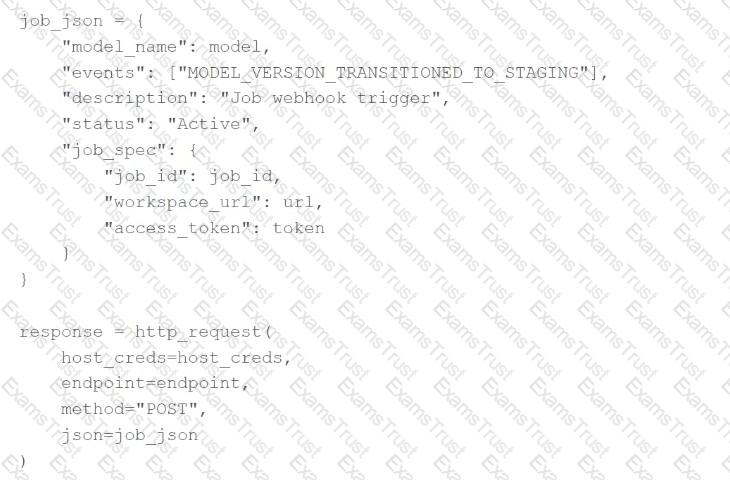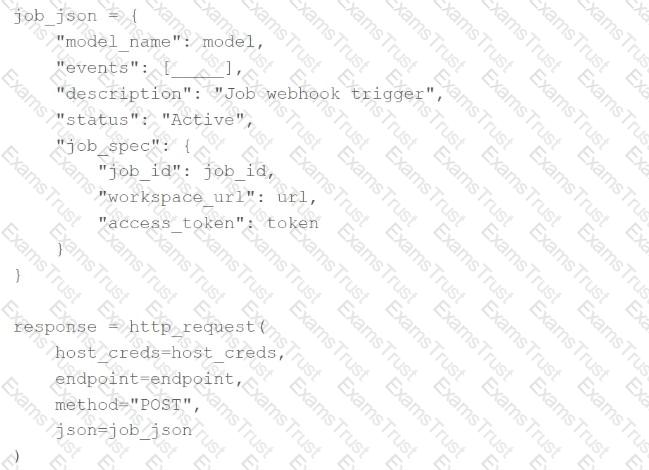A data scientist has developed a scikit-learn modelsklearn_modeland they want to log the model using MLflow.
They write the following incomplete code block:

Which of the following lines of code can be used to fill in the blank so the code block can successfully complete the task?
A machine learning engineering team has written predictions computed in a batch job to a Delta table for querying. However, the team has noticed that the querying is running slowly. The team has alreadytuned the size of the data files. Upon investigating, the team has concluded that the rows meeting the query condition are sparsely located throughout each of the data files.
Based on the scenario, which of the following optimization techniques could speed up the query by colocating similar records while considering values in multiple columns?
A machine learning engineer is in the process of implementing a concept drift monitoring solution. They are planning to use the following steps:
1. Deploy a model to production and compute predicted values
2. Obtain the observed (actual) label values
3. _____
4. Run a statistical test to determine if there are changes over time
Which of the following should be completed as Step #3?
A machine learning engineer and data scientist are working together to convert a batch deployment to an always-on streaming deployment. The machine learning engineer has expressed that rigorous data tests must be put in place as a part of their conversion to account for potential changes in data formats.
Which of the following describes why these types of data type tests and checks are particularly important for streaming deployments?
A machine learning engineering team wants to build a continuous pipeline for data preparation of a machine learning application. The team would like the data to be fully processed and made ready for inference in a series of equal-sized batches.
Which of the following tools can be used to provide this type of continuous processing?
A machine learning engineer has created a webhook with the following code block:

Which of the following code blocks will trigger this webhook to run the associate job?
A)

B)

C)

D)

E)

A data scientist has developed and logged a scikit-learn random forest model model, and then they ended their Spark session and terminated their cluster. After starting a new cluster, they want to review the feature_importances_ of the original model object.
Which of the following lines of code can be used to restore the model object so that feature_importances_ is available?
A data scientist has written a function to track the runs of their random forest model. The data scientist is changing the number of trees in the forest across each run.
Which of the following MLflow operations is designed to log single values like the number of trees in a random forest?
A machine learning engineer is manually refreshing a model in an existing machine learning pipeline. The pipeline uses the MLflow Model Registry model "project". The machine learning engineer would like to add a new version of the model to "project".
Which of the following MLflow operations can the machine learning engineer use to accomplish this task?
A machine learning engineer wants to view all of the active MLflow Model Registry Webhooks for a specific model.
They are using the following code block:

Which of the following changes does the machine learning engineer need to make to this code block so it will successfully accomplish the task?
A machine learning engineer wants to programmatically create a new Databricks Job whose schedule depends on the result of some automated tests in a machine learning pipeline.
Which of the following Databricks tools can be used to programmatically create the Job?
Which of the following tools can assist in real-time deployments by packaging software with its own application, tools, and libraries?
Which of the following deployment paradigms can centrally compute predictions for a single record with exceedingly fast results?
A machine learning engineer is attempting to create a webhook that will trigger a Databricks Jobjob_idwhen a model version for modelmodeltransitions into any MLflow Model Registry stage.
They have the following incomplete code block:

Which of the following lines of code can be used to fill in the blank so that the code block accomplishes the task?
Which of the following MLflow operations can be used to delete a model from the MLflow Model Registry?
A machine learning engineer wants to deploy a model for real-time serving using MLflow Model Serving. For the model, the machine learning engineer currently has one model version in each of the stages in the MLflow Model Registry. The engineer wants to know which model versions can be queried once Model Serving is enabled for the model.
Which of the following lists all of the MLflow Model Registry stages whose model versions are automatically deployed with Model Serving?
Which of the following describes the concept of MLflow Model flavors?
A machine learning engineer has developed a model and registered it using the FeatureStoreClient fs. The model has model URI model_uri. The engineer now needs to perform batch inference on customer-level Spark DataFrame spark_df, but it is missing a few of the static features that were used when training the model. The customer_id column is the primary key of spark_df and the training set used when training and logging the model.
Which of the following code blocks can be used to compute predictions for spark_df when the missing feature values can be found in the Feature Store by searching for features by customer_id?